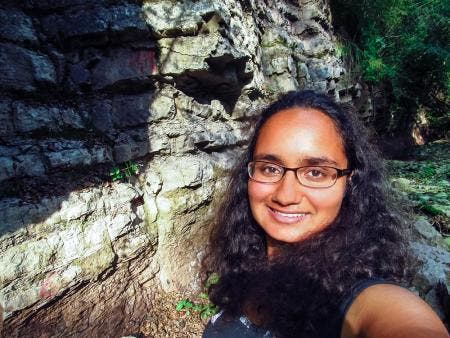Hima Hassenruck-Gudipati graduated this year from Caltech. She majored in mechanical engineering but minored in geology and her main area of interest was seeing how green technology and engineering can help mitigate the effects of climate change. Now, she has embarked on a global quest to understand the past, the present, and the future of climate change.

When Caltech wrote this article about her, she was walking alone in a creek some 50 km north of Venice, on the hunt for a particular rock which can provide insight into climate change. Without even relying on GPS coordinates, she relied only on a map and some indications with pictures of rocks. It wasn’t the wisest of decisions, as it took her quite a while (several hours) to finally reach her destination, but no regrets were felt.
“I felt like an explorer,” she recalls.
She finally reached her destination, an outcrop that formed the tall channel bank of the river along which she walked. This particular outcrop is especially important because it tells the tale of the Paleocene-Eocene Thermal Maximum, or PETM. The PETM refers to a climate event that began at the temporal boundary between the Paleocene and Eocene epochs some 55 million years ago; the event is absolutely stunning – over the course of only a few thousand years (which, in the geological past is nothing more than a blink), temperature rose by as much as 9 degrees Celsius! Just so you can get a relative idea, with all the man made global warming, temperatures have risen by 0.85 degrees Celsius in the past 100 years. Even though the PETM event has been studied and detailed for decades, the cause, details and overall significance of the event remain perplexing.
The PETM is one of the best known examples of past climate change, on a par with the Permian-Triassic mass extinction 250 million years ago, when the globe warmed by as much as eight degrees, wiping out about 90 percent of marine species and 70 percent of the animals on land. Better understanding these events would help us also understand what we are doing to the planetary climate now, and what the effects will be in the future.

Being interested in the shifting climate of the Earth, Hassenruck-Gudipati was fascinated when she first heard about the PETM. She wanted to learn more, applied for a scholarship, and took it home – she became one of the 44 students to get a Thomas scholarship for the 2014-2015 year. The fellowship, established by the Thomas J. Watson Foundation in 1968, offers graduating seniors of “unusual promise” a $28,000 stipend to support independent study and travel outside the United States.
Her itinerary is crazy. She spent the beginning of the summer in Italy and is now in Spain and will travel even more in months to come – probably to Australia, Nepal, New Zealand and potentially South Africa.
“It’s how the fellowship is set up,” she explains. “They encourage you to shape your itinerary based on what inspires you in the different places and take advantage of new opportunities as they arise.”
At each location, she will gather samples from previously identified outcrops which yield valuable information regarding climate change. She often teams up with geologists from other Universities or organizations, but for the most time, she travels alone.
Personally, I truly admire and encourage her initiative. I wish her good luck, and I’m confident that the results she will bring back home will help us paint a more accurate picture of past, present, and future climate change.


